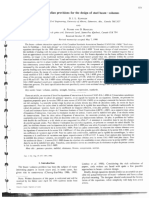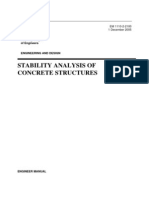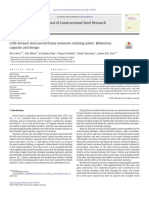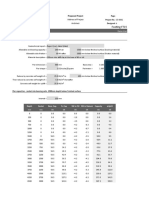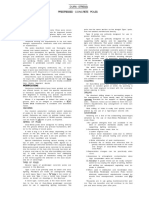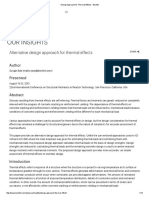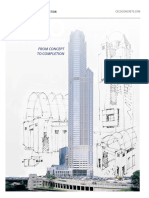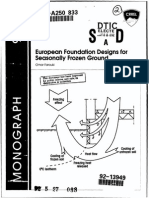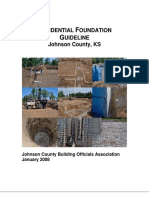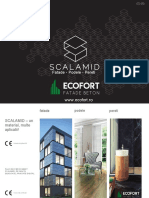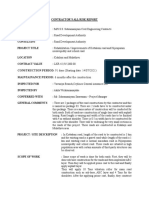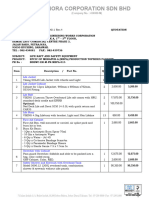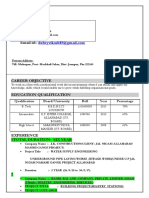energysmartdetails D i g l e s s , i n s u l at e m o r e
Because most rigid insulation is either 24 in.
Although not code-required,
from greenbuildingadvisor.com b y m a r t i n h o l l a d ay wide or 48 in. wide, it makes sense to design a
continuous horizontal insulation under
frost-protected shallow foundation to be 24 in. the slab can be used to reduce heat
deep at the perimeter, with 16 in. below grade loss through the floor.
Frost-protected
and 8 in. above grade.
Metal flashing with 1⁄4-in. drip leg
shallow foundations
Protective covering applied to
above-grade rigid foam
Around the perimeter of the slab,
vertical rigid foam insulates the
foundation.
T
he footings of most foundations are placed below the frost insulating your foundation walls enough to achieve the necessary
Horizontal wing insulation Builder’s tip
depth. In colder areas of the United States, this can mean R-value for a shallow foundation. extends out from the bottom
excavating and pouring concrete 4 ft. or more below grade. Let’s say you’re building a frost-protected shallow foundation in edge of the foundation, at Monolithic-slab
If you include enough rigid-foam insulation around a foundation, a Minnesota town with an air-freezing index of 2500. According to least 12 in. below grade, foundations require
to retain heat in the soil a perimeter trench.
however, you can keep the soil under the house warm enough to code requirements for frost-protected shallow foundations found near the building. It can be
If vertical insulation
permit shallow excavations, which can be 12 in. or 16 in. deep, even in Table R403.3 of the IRC, the minimum R-value of the verti- sloped slightly away from the
foundation for drainage. is installed inside
in northern areas. cal insulation at the perimeter of the slab is R-6.7 (about 11⁄2 in. of the formwork
So-called frost-protected shallow foundations usually consist of a XPS). Ironically, the energy section of the IRC, which applies to all before the pour,
Footing drains are not
monolithic (thick-edged) slab wrapped with vertical and horizontal types of slabs, not just those that are frost-protected, requires more necessary, but the slab and
the trench and the
rigid-foam insulation. Although the International Residential Code slab-edge insulation, R-10, for slabs commonly built with full-depth horizontal insulation should sit foam board can
(IRC) does not require a shallow foundation to have insulation footings in this climate zone. on a 4-in.-thick compacted layer act as the lower
of crushed stone, and the site section of the form.
below the slab, omitting the subslab insulation is not a good idea. The R-value for the horizontal wing insulation in this example is must be properly graded.
After all, the more insulation you have under the slab, the less heat R-4.9. Table R403.3 also specifies the minimum width and configu-
will leak out of your house into the soil below. Fortunately, these ration of the wings. 6-mil. polyethylene under slab
shallow foundations don’t depend on leaking building heat to keep Now that minimum energy-code requirements for slab insulation Download these details to print or open in CAD
software at www.greenbuildingadvisor.com/cad.
the soil warm. Instead, horizontal wing insulation extending from have overtaken the design requirements for a frost-protected shal-
the bottom edge of the slab helps to retain the natural warmth of low foundation, the line between a “conventional” slab-on-grade Horizontal insulation
the earth. foundation and a frost-protected shallow foundation has been
Either extruded-polystyrene (XPS) or denser types of expanded- blurred. As a result, almost any monolithic slab complying with
polystyrene (EPS) insulation may be used to insulate a frost- energy-code requirements can be turned into a frost-protected shal- Air-freezing index determines R-value
protected shallow foundation. To account for the possible perfor- low foundation by adding the required wing insulation. Foundation
To calculate the necessary R-value of the foam needed for a frost-protected shallow
mance degradation of foam insulation that remains buried for years, For more information, see “Revised Builder’s Guide to Frost Pro- perimeter
foundation, most designers look up the air-freezing index for the area in which they are
designers “derate” the presumed R-value of XPS from its nominal tected Shallow Foundations” (www.toolbase.org/PDF/Design
building. The higher the index, the colder the climate. Design guidelines for frost-protected
value of R-5 per in. to R-4.5 per in. The amount of insulation you’ll Guides/revisedFPSFguide.pdf).
shallow foundations can be found in an American Society of Civil Engineers publication
need depends on the air-freezing index in your area. Coincidentally, “Design and Construction of Frost-Protected Shallow Foundations” (ASCE 32-01). However, C
because of existing energy-code requirements, you may already be Martin Holladay, contributing editor most residential builders will probably find it easier to follow the prescriptive requirements
for these foundations in section R403.3 of the IRC, also shown here. A
C
Pros and a few caveats Air-freezing index
B
Frost-protected shallow foundations have Frost-protected shallow foundations don’t below-grade rigid-foam insulation is not Air-freezing Vertical Horizontal Horizontal
(oF days) index insulation insulation insulation
Horizontal insulation
the following advantages over deeper make sense everywhere, though. necessarily a good idea A simplified analysis of the 100-year return period
conventional foundations. At walls At corners A B C
• If you live where frost depths are already • Deep-rooted perennial plants shouldn’t
• They require less excavation, so smaller shallow, don’t expect any savings in labor be planted above the shallow wing insula- <1500 R-4.5 NR NR NR NR NR
equipment and less labor are involved. or material, though an insulated founda- tion that surrounds a house with a frost- 2000 R-5.6 NR NR NR NR NR
tion may save energy dollars later. protected shallow foundation.
• Less concrete is consumed. 2500 R-6.7 R-1.7 R-4.9 12 in. 24 in. 40 in.
• Frost-protected shallow foundations aren’t • The above-grade portions of the verti-
• Monolithic slabs are formed and poured in 3000 R-7.8 R-6.5 R-8.6 12 in. 24 in. 40 in.
appropriate for steeply sloped sites or cal foam insulation surrounding a shallow
one shot, speeding the work schedule.
sites with permafrost. foundation need to be protected with a
>4000
>3000-4000 3500 R-9 R-8 R-11.2 24 in. 30 in. 60 in.
>2000-3000
• They typically cost 15% to 21% less than durable finish material, such as Protecto >1000-2000
• In areas that are heavily infested with ter- >0-1000 4000 R-10.1 R-10.5 R-13.1 24 in. 36 in. 60 in.
a conventional foundation, according to a Wrap Protecto Bond or stucco over metal 0
mites, including the southeastern United
study by the NAHB Research Center. or fiberglass lath.
The amount of insulation needed to protect a building 4500 R-12 R-12 R-15 36 in. 48 in. 80 in.
States and most of California, the use of foundation is determined by the air-freezing index.
84 FINE HOMEBUILDING Drawings facing page: Steve Baczek (top); Dan Thornton (center, bottom). www.finehomebuilding.com december 2010/january 2011 85







